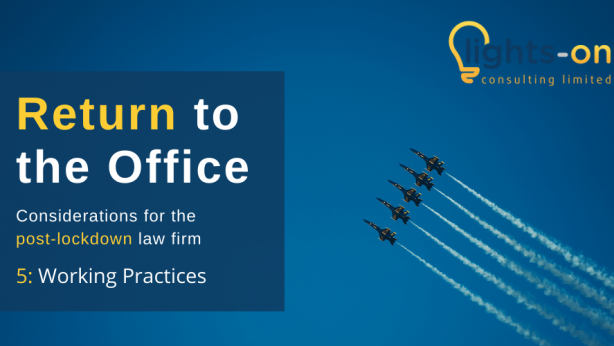In our previous Return to the Office articles the Lights-On team has explored the considerations for a post-lockdown law firm, with articles focusing on People and Workplaces, IT Service, Technology, and Governance.
In this, our final piece in the Return to the Office series, our team of IT Project Consultants (Robin Boyle, Harvey Evans, Martin Kay and Colin Mounsey) assess how the COVID-19 pandemic may create long-term change in law firms’ working practices.
 Drawing on their collective experience of implementing IT and technology solutions and services in the world of legal, the team focuses on the practical application of technology to support new working practices, covering:
Drawing on their collective experience of implementing IT and technology solutions and services in the world of legal, the team focuses on the practical application of technology to support new working practices, covering:
- Business process
- Logistics and the implications of office working
- Travel
- Dealing with potential future lockdowns
The impact of COVID-19 on working practices could be dramatic. As a ‘non-tech’ example to make a point, take dress-codes. It is tradition to wear suits in the legal sector but very few have worn them at home! Firms to date have explored dress down policies or “no client, no suit” policies in the office but what happens now? Has the informality of home working created a gap for a far more relaxed dress code? Is this the death of the suit? Most importantly – can we still fit in them?!
In terms of real estate, we have seen firms set to exercise break clauses and a few forward-looking firms deciding that office space is now just for meetings and face-to-face workgroup collaboration, with plans to run their business in a completely different, more virtual way.
All firms are looking at using fewer desks as a result of social distancing needs and many of these will morph to hot desking when it is allowed again. The legal sector may be about to take a significant leap forward in adopting the operating models of companies like the big 4 accountancy firms, tech and media industries. It could easily be one of the most radical changes for legal to date…if we want it to be.
The point is, change won’t happen if we don’t take positive action and quickly. The return to the office will be like pouring concrete: it will set quickly in the mould so, if you are going to change the mould, do it before you pour the concrete!
Our final article finishes on a wider brief than just technology although technology could be used to underpin most of the topics we cover here.
Post COVID-19 working practices – considerations for the legal sector

Hybrid home and office working – Presence-based management is very different to remote management and a hybrid of the two can be even more complex. There are concerns particularly around supervision of trainees and junior lawyers, training, management structures and people development. Online HR, L&D and people management systems and the digitisation of these management tools, including an acceptance of the video appraisal, may be upon us and should be considered.
Admin processes – How well did your admin processes stand up to the tests of home working? Many of the HR, Admin and Finance related processes may have suffered from lack of electronic based workflow and yet digitisation of these processes, together with approvals and notifications, will be critical to facilitate remote and hybrid working practices.
Transacting and authorising – To date we have signed in wet ink and are obligated to do for the likes of many financial transactions, deeds and wills. We are constrained by the law and have a ridiculous position where it is acceptable to witness a will through a window but not by video. E-signing is now on the law firm agenda but needs to be on government and courts’ agendas too and we will need strong technology for authentication, audit and integration into our other key systems to make this embed further.
Paperless – Everyone has skirted around paperless and re-badged it “paper light” so as not to worry those that don’t like their cheese being moved but, in lockdown, paperless is the only real solution. There will be people returning to the office whose first thought will be to print the 200-page contract to thumb through it in the old familiar way. What is your firm going to do to cast a new mould on this model? You need to act quickly and before they return to the office.
Training approaches – Many firms have already “played” with this and often used it only for limited applications such as compliance training or the likes. If we do adopt true location flexibility, the depth and breadth of this will have to be re-examined and technology adopted that can help with all manner of topics and learning styles. We have already seen examples of law firms going live on new PMS systems whilst in lockdown using e-learning and e-support. This would otherwise have been unheard of without the imperatives created by the pandemic.
People management – Team briefings in an office-based environment are reasonably straightforward. In a hybrid office and home-based environment and accommodating flexible working, such things are far more complex and it is hard to get them right. Technology can help with video broadcasts, webinars and question/poll technologies but managing such technologies whilst trying to focus on a message and delivery is hard. New “broadcaster” skills will be required and this may be the presenter but likely to also stretch to admin support for tech-complex meetings allowing the admin person to handle the “technical elements” of the session (such as Q&A, raising hands, note taking) and the manager to manage the message and quality of delivery / interaction. Some lawyers struggle with PowerPoint presentations so combining this with broadcast technology may need a little more support to be effective.
Virtual introductions – New client relationships may have to start virtually in the future. Are there any techniques / skills training required to be able to put the best virtual foot forward? Reading the room and eye contact don’t work well on VC so do your staff need training on ‘effective Video conferencing’ for engaging new business, closing deals, pushing projects along? This becomes even more critical on introductions, where first impressions count.
Remote Project Management – With technology projects requiring attention, project management can be done remotely as we previously wrote about here. It is different but it can be done well. What projects do you have that have a sense of urgency and need some project management? How will meetings be conducted? Who will attend? When will meetings be held to allow for both office-based workers and home workers? How frequent will the meetings be? How will progress and issues be recorded?
The Courts – English courts have conducted some hearings using which has had a knock-on effect for firms. This has been the catalyst for paperless bundling and technology has assisted with this with a necessary growth in e-bundling. How will firms support hearings going forward? What practices, training and technology needs to be implemented to do this well? Those that do it well and with confidence may clearly have an advantage.
Third party liaison – We have increased our electronic communications with traditionally paper hungry bodies such as barristers, counsels’ chambers and costs draftsmen. We have seen some firms refuse to send out paper to costs draftsmen before the pandemic and require them to print at their own costs, so the movement started well before the pandemic but perhaps we can use this as a spring board for new ways of working.
IT budget to support new e-working and digital practices – On one hand an uncertain economic climate may encourage firms to lean towards cautious budgets but, on the other hand, the pandemic has shown the total reliance on IT to be able to conduct business. Whilst some firms may freeze all spending and technology project work, other firms are seizing the opportunity and have continued with procurement projects during lockdown. What we are seeing now more than ever is a focus on the practical use of technology. Mobility, paperless, e-authorisation and collaboration technology are back in the limelight, relegating artificial intelligence (AI) to the second row – for now. Law firms should stretch IT budgets to ensure that the basics are delivered and delivered well and that the mobilised workforce is extremely competent at managing its technology without the need for an IT person to be present.
Recruitment and onboarding of new staff – During lockdown, a number of law firms have interviewed candidates by video. Is this likely to continue? It can be a superbly effective vetting process and will test your subjects’ ability to work in a digital environment. Irrespective of changes to social distancing guidelines, video interviews are an approach worth exploring to help streamline recruitment processes. The opportunities open to your law firm to establish new working practices.
Change has been forced upon us and we have used technology in far deeper and wider ways than ever before. Firms behind the curve have faced very challenging times and those that have mobility and mobile working at the core have been able to lead the pack in continuing to deliver service to clients.

People have adapted well to using technology and, in doing so, it has broken down some of the walls that existed and a lack of willingness to try.
Further digitisation of your workforce presents enormous opportunity that will go beyond disaster recovery or business resilience from further outbreaks. It has long been claimed that flexible working helps with return to work and staff retention, but now it may be that those embracing wider adoption may truly be at an advantage in the workplace. An expert lawyer you want to recruit, who may not have previously considered your firm due to its geography, may be far more receptive if we truly break down geographical boundaries and embrace remote working.
Widescale adoption, upskilling and management of a broad brush of tech will take effort and money in uncertain economic times and when firms are busy struggling to survive and prosper. It will therefore only be the bold and well-managed firms that can really benefit from the experiences and opportunities of recent weeks and months.
If you are a law firms that believes fortis fortuna adiuvat*, then we encourage you to take swift action to establish your new and improved working practices. The opportunity for change – and your people’s receptiveness to change – may decline exponentially upon return to the office.
There we have it folks. This marks the final piece in the Lights-On Consulting Return to the Office series of articles for law firm leaders and their IT teams. You can access the other pieces on our News page and keep an eye on our updates on our LinkedIn page. We wish all of our law firm clients and contacts the very best as you make your post-lockdown plans and look forward to catching up with you over the coming months.
*Fortune favours the brave (for those who had not yet googled it).
Return to the office: considerations for the post-lockdown law firm – Introduction
Return to the office: Considerations for the post-lockdown law firm – People and workplaces
Return to the office: Considerations for the post-lockdown law firm – IT service
Return to the office: Considerations for the post-lockdown law firm – Technology
Return to the office: Considerations for the post-lockdown law firm – Governance

